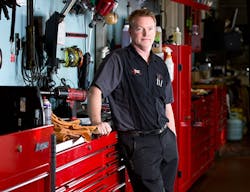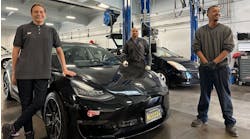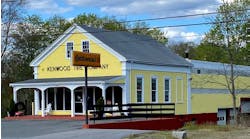Back in 2008, Eric Svedberg received news no auto shop owner is eager to hear: The major intersection in front of his business in Virginia Beach, Va., was going to be moved via road construction.
The intersection was only going to be shifted perhaps a quarter mile away from Svedberg’s Automotive Specialists facility; yet, to the shop owner, it felt like an emphatic shove into certain irrelevance.
“I was on a major, major intersection, with a huge amount of traffic in front of me,” Svedberg says with regard to his shop. “Now I would not be on the intersection. So, I’m used to tens of thousands of cars seeing me on a daily basis. … Now that I’m not as easily seen, I might have to do something.
“That’s when I really hunkered down and decided, ‘OK, I’m going to have a new plan. And that’s when I really started getting serious with more marketing.
“That was a wake-up call.”
As it turns out, there was no need for alarm: Nine years later, Automotive Specialists is in the midst of a lengthy stretch of prosperity.
And, the auto shop’s owner is widely respected for his array of marketing techniques, which help him bring in more than $1 million in annual revenue from a three-lift facility.
Forging A Philosophy
When Svedberg first entered the auto industry at the age of 22, he had little marketing expertise, and no real mentor to learn from.
“It was the school of hard knocks,” he says.
Yet, Svedberg was willing to be humble, gleaning tips anywhere he could. Over the years, the Virginia shop owner took classes at VISION Hi-Tech Training & Expo in the Kansas City area, picked the brains of fellow owners, and read International Automotive Technicians Network (iATN) forums voraciously.
He also wasn’t afraid to borrow ideas. For example, Automotive Specialists’ logo looks awfully similar to that of Boar's Head meat & cheese, a deli product of which Svedberg is a fan.
“I definitely wanted to learn from the best,” Svedberg explains. “I took everything I could get, and then applied what worked for me.”
Through all that studying and observing, Svedberg developed a guiding marketing strategy: the use of the 80/20 rule.
“So, on 80 percent, I feel like I’m marketing toward my existing customer base—to make sure that they’re coming in, staying consistent. I’m seeing them two to three times a year. And then I’m always replacing, or adding to my customer base [by] 20 percent,” he says.
Determining Your Brand
One other key juncture of Svedberg’s career inspired his interest in marketing. Long ago, Svedberg’s shop was an Amoco facility, but the owner eventually made the difficult decision to strike out on his own in 2002. (Svedberg says Amoco was focusing on convenience-store operations at the time, so he crunched the numbers, considering factors like payroll and rent to Amoco, and decided to part ways.)
That meant, of course, that his shop’s built-in brand awareness had quickly gone out the window.
“When I had to make the decision of kicking Amoco out and going strictly on my own, it was a little scary,” Svedberg, now 45, recalls. “So, if I wanted to put food on the table, I had to learn the importance of marketing, to make sure that I had that new customer base building.”
Eventually, Svedberg, who has owned his shop for 23 years, came to the conclusion that he would establish his marketing budget at 6 percent. The industry veteran would aim to differentiate his business from its competitors. And, finally, he would attempt to put his shop’s name out in the community at every opportunity.
“You have to start with what your brand is,” Svedberg says. “And, if you think your brand is ‘I fix cars,’ there’s 50 other [shops] around, so that’s not going to be very successful. … So what’s your brand, and how are you going to differentiate yourself?”
TIP FOR HANDLING COMEBACKS
An auto shop staff can even use comebacks as a means to market its business, as Eric Svedberg, owner of Automotive Specialists in Virginia Beach, Va., can attest.
“I have a stack of Starbucks gift cards in my desk drawer, each of them worth $25—that’s in my marketing budget,” Svedberg says. “If we mess up anything on your car, if you have to come back and see us for something, and we inconvenienced you … we write [customers] a note, stick the Starbucks card in it, we mail it to them and apologize that they had to take time out of their day and their life to come see us a second time, and that’s not acceptable. That goes over huge.”
Six Key Principles
Inspiration can be found in strange places. Even coffee cups, as it turns out.
In his studies of America’s top marketers, Svedberg came to the conclusion that Starbucks is virtually without peer. As such, the Virginia shop owner has attempted to copy the international coffee company’s constant pursuit of customers.
That’s just one marketing belief of many for Svedberg. Here are six marketing principles Svedberg believes other shop owners can use to grow their businesses:
1. Have a brand.
“First and foremost,” Svedberg says, “you have to have something to market. So build your brand. What’s your brand, and what makes you different—what would make people want to come see you?”
The industry veteran suggests that other shop owners consider differentiating their business by specializing in certain makes, having the best electrical techs in the area, or being a one-stop shop, for example. Once a shop’s brand is established over time, the community will recognize it, Svedberg insists.
2. Have a budget and a plan.
Svedberg utilizes a 6 percent marketing budget. “You can do a lot with 6 percent, depending on what your sales are,” he says. “Then, track that with different phone numbers, asking the customers, tracking it on your point of sale system.”
The Virginian says a 6 percent marketing budget “is good for me, but I also think the number should be fluid; 4 percent for some, or 8 percent for others. If you have a number and it is on your balance sheet, you’re more likely to use it and reap the benefits. Crunch the numbers and see what works for your market, demographic, shop and neighborhood.”
3. Market consistently.
“Whatever you’re going to market,” Svedberg contends, “you should be dialed into at least six months or a year of consistency. You can’t say, ‘OK, I’m going to do this for one month, and then I’m going to switch gears.’ It takes that consistency for you to start seeing that pay-off.”
Svedberg uses digital marketing in many forms, such as Google AdWords, but his craftiest marketing may come courtesy of a digital newsletter that features a $10 coupon. It’s the only discount he utilizes. That way, when customers ask if his shop has any coupons, the owner can say, "Sure, let me sign you up for our [quarterly] newsletter right now, and you can have the $10 coupon.’”
4. Think locally.
“I want to own my three-mile radius. I want to know every school, I want to know every church,” Svedberg says. “And anything anyone wants, as far as if they want car washes, they want donations, they want anything that’ll get my name and my brand in front of my three-mile radius, I think it will make me successful—it just keeps my name in front of everyone.”
5. Build relationships.
Express a genuine interest in your customers. Svedberg says, “The more I can talk to people about their kids, their kids getting married, where they went on vacation, what’s new in their life, and the less I can talk about cars, the easier it is to sell car services.”
6. Don’t market everything.
Avoid marketing prices, such as cheap oil changes, Svedberg contends. “I don’t market [by saying], ‘Hey, hurry up and come on down, I can get your state inspection in; we’re not busy at all,’” he says. “Nobody wants to go to a restaurant that has nobody in the parking lot, right? Because the food’s probably not that good.
“Even if we’re a little bit slower, a lot of times, if you want to come see me, it’s [still] going to be tomorrow or the next day, and we’re going to make an appointment. That’s subliminal a little bit, as far as, ‘Hey, these guys must be really good—they’re busy.’”
Stay In Search Of New Tactics
Svedberg’s days of worrying about road construction or the impact of leaving franchise security are in the rearview mirror.
Automotive Specialists has grown for 10 straight years, the owner says, with growth between 3 percent and 12 percent per year. The shop is also growing with a minimum 20 percent new customer acquisition each month, on average, Svedberg says.
One key to that growth: Svedberg never stops searching for new ways to market his business. He spends nearly $200 per month to have a Florida marketing firm tend to his shop’s social media channels. Additionally, Svedberg recently started advertising with the navigational app Waze, which recently got his business 210,000 impressions in a month.
If there’s an overarching trick to mastering marketing, Svedberg indicates that it’s using a versatile, expansive plan of attack. Years after marketing duties were initially forced upon him, the Virginian welcomes the role nowadays.
“I actually enjoy marketing,” Svedberg says. “After you get really good at all of it, it works on a long-term-strategy basis.”



